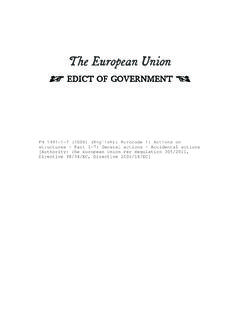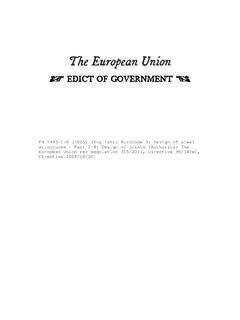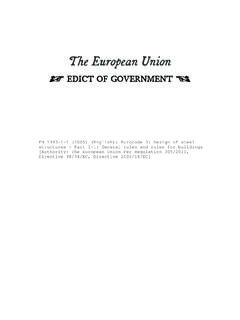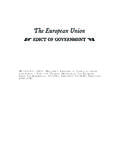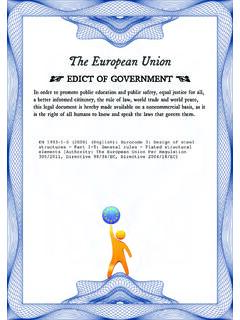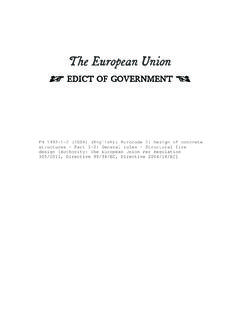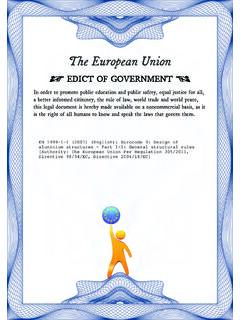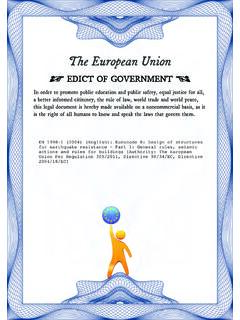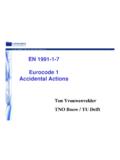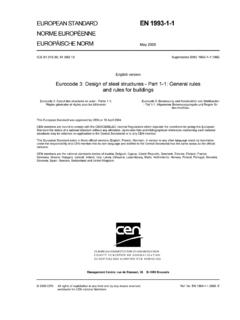Transcription of EN 1993-1-6: Eurocode 3: Design of steel structures …
1 The European UnionIn order to promote public education and public safety, equal justice for all, a better informed citizenry, the rule of law, world trade and world peace, this legal document is hereby made available on a noncommercial basis, as it is the right of all humans to know and speak the laws that govern them. EDICT OF GOVERNMENT EN 1993-1-6 (2007) (English): Eurocode 3: Design of steelstructures - Part 1-6: Strength and stability of shellstructures [Authority: The European Union Per Regulation305/2011, Directive 98/34/EC, Directive 2004/18/EC]EUROPEAN STANDARD NORMEEUROPEENNE EUROPAISCHE NORM EN 1993-1-6 February 2007 les ; Incorporating corrigendum April 2009 Supersedes ENV 1993-1-6: 1999 English Version Eurocode 3 - Design of steel structures -Part 1-6: Strength and Stability of Shell structures Eurocode 3 -Calcul des structures en acier Partie 1-6: Re sistance et stabilite des structures en coque Eurocode 3 -Bemessung und Konstruktion von Stahlbauten - Teil 1-6: Festigkeit und Schalen This European Standard was approved by CEN on 12 June 2006.
2 CEN members are bound to comply with the CEN/CENELEC Internal Regulations which stipulate the conditions for giving this European Standard the status of a national standard without any alteration. Up-to-date lists and bibliographical references concerning such national standards may be obtained on application to the CEN Management Centre or to any CEN member. This European Standard exists in three official versions (English, French, German). A version in any other language made by translation under the responsibility of a CEN member into its own language and notified to the CEN Management Centre has the same status as the official versions. CEN members are the national standards bodies of Austria, Belgium, Bulgaria, Cyprus, Czech Republic, Denmark, Estonia, Finland, France, Germany, Greece, Hungary, Iceland, Ireland, Italy, Latvia, Lithuania, Luxembourg, Malta, Netherlands, Norway, Poland, Portugal, Romania, Slovakia, Slovenia, Spain, Sweden, Switzerland and United Kingdom.
3 EUROPEAN COMMITTEE FOR STANDARDIZATION COMITE EUROPEEN DE NORMALISATION EUROpAISCHES KOMITEE FUR Management Centre: rue de Stassart, 36 B 1050 Brussels 2007 CEN All rights of exploitation in any form and by any means reserved worldwide for CEN national Members. Ref. No. EN 1993-1-6: 2007: E BS EN 1993-1-6: 2007 EN 1993-1-6: 2007 (E) Contents 1. General ].] Scope ].2 Normative references Terms and definitions Symbols ].5 Sign conventions 2 Basis of Design and nlodelling General Types of analysis She]] boundary conditions 3 Materials and geOlnetry Material properties Design values of geometrical data Geometrical tolerances and geometrical imperfections 4 Ultimate limit states in steel shells 4.] Ultimate limit states to be considered Design concepts for the limit states Design of shells 5 Stress resultants and stresses in shells Stress resultants in the she]] Modelling of the shell for analysis Types of analysis 6 Plastic limit state (LSI) 6.
4 ] Design values of actions Stress Design Design by global numerical MNA or GMNA analysis Direct Design 7 Cyclic plasticity limit state (LS2) Design values of actions Stress Design Design by global numerical MNA or GMNA analysis Direct Design 8 Buckling liInit state (LS3) Design values of actions Special definitions and symbols Buckling-relevant boundary conditions Buckling-relevant geometrical tolerances Stress Design Design by global numerical analysis using MNA and LBA analyses Design by global numerical analysis llsing GMNIA analysis 9 Fatigue linlit state (LS4) 9.] Design values of actions Stress Design 2 Page 4 4 5 6 11 15 15 15 15 17 18 ]8 ]8 18 19 ]9 20 23 23 23 26 26 26 26 27 28 28 28 29 29 30 30 30 30 31 3] 38 40 43 48 48 48 Design by global numerical LA or GNA analysis ANNEX A (normative) Membrane theory stresses in shells General Unstiffened cyl1ndrical shells Unstiffened conical shells AA Unstiffened spherical shells ANNEX B (normative) Additional expressions for plastic collapse resistances General Unstiffened cylindrical shells Ring stiffened cylindrical shells BA Junctions between shells Circular plates with axisymmetric boundary conditions ANNEX C (normative)
5 Expressions for linear elastic melllbrane and bending stresses General Clamped base unstiffened cylindrical shells Pinned base unstiffened cylindrical shells Internal conditions in unstiffened cylindrical shells Ring stiffener on cylindrical shell Circular plates with axisymmetric boundary conditions ANNEX D (nornlative) Expressions for buckling stress (5) text deleted ~ Unstiffened cylindrical shells of constant wall thickness Unstiffened cylindrical shells of stepwise variable wall thickness Unstiffened lap jointed cylindrical shells DA Unstiffened complete and truncated conical shells Foreword BS EN 1993-1-6: 2007 EN 1993-1-6: 2007 (E) 49 50 50 50 51 52 53 54 54 54 55 57 59 62 63 63 63 64 66 68 69 71 73 73 73 83 88 90 This European Standard EN 1993-1-6, Eurocode 3: Design of steel structures : Part 1-6 Strength and stability of shell structures , has been prepared by Technical Committee CEN/TC250 Structural Eurocodes , the Secretariat of which is held by BSl.
6 CEN/TC250 is responsible for all Structural Eurocodes. This European Standard shall be given the status of a National Standard, either by publication of an identical text or by endorsement, at the latest by August 2007, and conflicting National Standards shall be withdrawn at latest by March 20 I O. This Eurocode supersedes ENV 1993-1-6. According to the CEN-CENELEC Internal Regulations, the National Standard Organizations of the following countries are bound to implement this European Standard: Austria, Belgium, Bulgaria Cyprus, Czech Republic, Denmark, Estonia, Finland, France, Germany, Greece, Hungary, Iceland, Ireland, Italy, 3 BS EN 1993-1-6: 2007 EN 1993-1-6: 2007 (E) Latvia: Lithuania, Luxembourg, Malta, Netherlands, Norway, Poland, Portugal, Romania, Slovakia, Slovenia, Spain, Sweden, Switzerland and United Kingdom.
7 National annex for EN 1993-1-6 This standard gives alternative procedures, values and recommendations with notes indicating where national choices may have to be made. Therefore the National Standard implementing EN 1993-1-6 should have a National Annex containing all Nationally Determined Parameters to be used for the Design of steel structures to be constructed in the relevant country. National choice is allowed in EN 1993-1-6 through: (4) (3) (1) (5) (1) (1) (3) (2) (4) (4) (1) (2) (4) (7) (16) (18) (2 times) (2)P 1. General Scope (]) EN 1993-1-6 gives basic Design rules for plated steel structures that have the form of a shell of revolution. (2) This Standard is intended for use in conjunction with EN 1993-1-1, EN 1993-1-3, EN 1993-1-4, EN 1993-] -9 and the relevant application parts of EN 1993, which include: Part for towers and masts; Part for chimneys; Part for silos; Part for tanks; Palt for pipelines.
8 (3) This Standard defines the characteristic and Design values of the resistance of the structure . 4 BS EN 1993 1 6:2007 EN 1993-1-6: 2007 (E) (4) This Standard is concerned with the requirements for Design against the ultimate limit states of: plastic limit; cyclic plasticity; buckl ing; fatigue. (5) Overall equilibrium of the structure (sliding, uplifting, overturning) is not included in this Standard, but is treated in EN 1993-1-1. Special considerations for specific applications are included in the relevant application parts of EN 1993. (6) The provisions in this Standard apply to axisymmetric shells and associated circular or annular plates and to beam section rings and stringer where they form part of the complete structure . General procedures for computer calculations of all shell forms are covered.
9 Detailed expressions for the hand calculation of unstiffened cylinders and cones are given in the Annexes. (7) Cylindrical and conical panels are not explicitly covered by this Standard. However, the provisions can be applicable if the appropriate boundary conditions are duly taken into account. (8) This Standard is intended for application to steel she11 structures . Where no standard exists for shell structures made of other metals, the provisions of this standards may be applied provided that the appropriate material properties are duly taken into account. (9) The provisions of this Standard are intended to be applied within the temperature range defined in the relevant EN 1993 application parts. The maximum temperature is restricted so that the int1uence of creep can be neglected if high temperature creep effects are not covered by the relevant application part.
10 (10) The provisions in this Standard apply to structures that satisfy the brittle fracture provisions given in EN 1993-1-1 O. (11) The provisions of this Standard apply to structural quasi-static in nature. under actions that can be treated as (12) In this Standard, it is assumed that both wind loading and bulk so1ids flow can, in general, be treated as quasi-static actions. (13) Dynamic effects should be taken into account according to the relevant application part of EN 1993, including the consequences for fatigue. However, the stress resultants arising from dynamic behaviour are treated in this part as quasi-static. (14) The provisions in this Standard apply to structures that are constructed III accordance with EN 1090-2. (15) This Standard does not cover the aspects of leakage.
